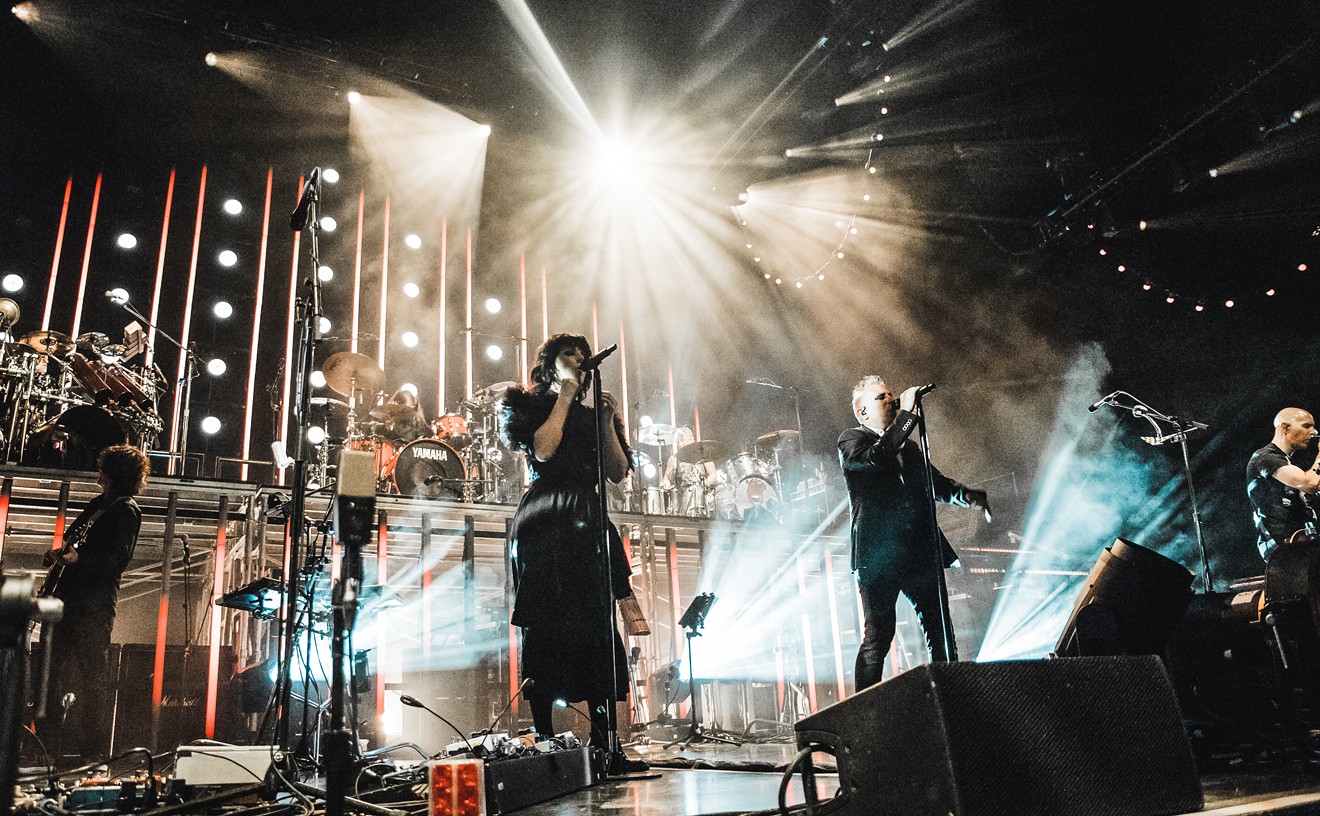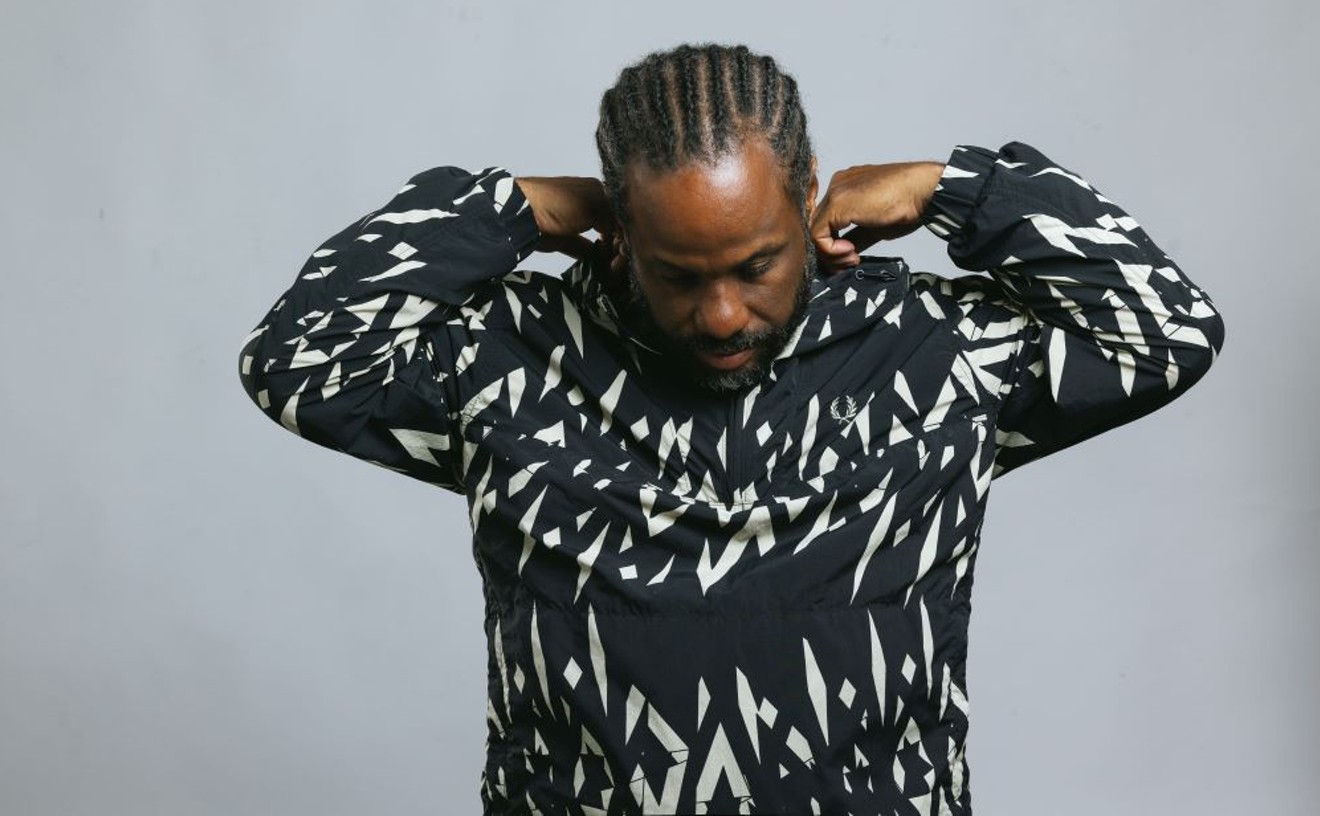It’s hard to imagine that any of us could ever develop an emotional connection to any of the sterile corporate live music venues here in the DFdub. We don’t think fondly of places where the employees wear headsets and matching uniforms, scowl into walkie-talkies or feel the need to cavity search the patrons on their way in the front door.
Fuck that homeland security shit.
How many of us would gladly trade in the House of Blues, Firewater or The Palladium to have back Trees, Arcadia Theatre or the Bronco Bowl?
We’ve seen a lot of distinctive music venues come and go over the years. Thankfully, a few timeless classics like Black Forest Theatre, Sons of Herman Hall and the Majestic Theatre still remain. And all of them have had their individual stories. They’ve all had their good nights and their disasters.
But few have the morbid legacy of the Longhorn Ballroom.
Bill Wisener recently took a few minutes to share a few of his personal experiences with the man who actually built the Longhorn Ballroom back in 1950. “O.L. Nelms was the most colorful local millionaire around,” says Wisener, between drags on a Camel at his South Dallas record store. “I first met him in 1965; I was 21 years old. Mr. Nelms was the most prominent landowner in Dallas at the time. Among all of his various properties, he had this old racetrack called the Yello-Belly Drag Strip, he had the old Sanger-Harris building downtown, and that hotel in Oak Cliff that is now called Belmont.”
Nelms took a likin’ to “Billy”, and he treated Wisener like a son: “When I was in my early 20s, Mr. Nelms used let me run the lights at the drag strip. He took me with him everywhere and introduced me to everyone like we were family.”
O.L. Nelms even helped Bill start up a business in Pleasant Grove. “Mr. Nelms had a fourth grade education. He talked about it all the time; it was like he was proud of it” says Wisener. “When he was a kid he used to sell pencils on the streets of downtown Dallas."
But O.L. Nelms was a self-made millionaire who loved the idea of making other people’s dreams come true.
“The first night that I met him,” Wisener says, “he drove me around town and showed me all of his properties. He told me, ‘Just pick any property you want.’ And he put me in business. That’s how I started the ‘King Putt’ miniature golf course.”
Nelms also founded the venue that still sits at the corner of Cadiz and Industrial.
“Mr. Nelms originally built the Longhorn nightclub for Bob Wills,” Wisener says. “At first, it was called the Bob Wills Ranch House. Jack Ruby managed it for a short time. After a few years, Bob just gave it to Dewey Groom for almost nothing. I guess Bob was having financial difficulty during that time, and just he gave Dewey the club."
Groom and Wisener soon became friends as well.
“Dewey lived in Pleasant Grove at the time, and would always bring his family to my miniature golf course every weekend. He always looked sharp and was very polite and respectful to me. Of course, everybody in town loved him.”
Beyond the Longhorn Ballroom, O.L. Nelms also had big plans for his own demise.
“Mr. Nelms was famous for wanting to promote this big event called ‘The Dead Man’s Party’. He claimed that he had put $5,000,000 aside for his own funeral,” explains Wisener.
It was to be the mother of all blowouts.
“Mr. Nelms wanted to have this massive event where his body was to have been wheeled out in a glass-top casket, and everybody in the place was allowed to drink for free all night until the last person went home."
To this day, Wisener still insists on referring to him as “Mr. Nelms” and speaks of the man as if referring to a long lost family member.
O.L.Nelms died in 1972.
During this same time period, the Longhorn Ballroom began a transition to also catering to a new African-American clientele. Longtime Dallas music promoter Angus Wynne remembers when it was premier showcase room for the contemporary rhythm and blues artists of that era.
“During the late ‘60s and early ‘70s, I used to go see all of the great soul shows at Longhorn Ballroom on Sunday and Monday nights,” Wynne recalls. “Most of the black community in Dallas at the time worked in the service industry, so Sunday and Monday nights were their night to go out on the town.
“I saw James Brown there, Otis Redding, performers like that. It was the coolest place to see a show, because once you got inside, there was no law. People were smoking reefer, they brought their own booze. You could do whatever you wanted, as long as you didn’t fight anybody."
The venue kept two off-duty African-American police officers on hand for a lot these shows, but they weren’t there to arrest anybody—just to keep the peace. The Longhorn was also way ahead of the curve when it came to personalized table service.
“You would go in there and buy a table and they would set it up for you," says Wynne. “And that was your table all night; they would serve you setups, because they didn’t have a liquor license. It was just beer and wine. There were inexhaustible jars of pickled pigs feet on the bar and the soul food there was just tremendous. And there was a craps table set up in the men’s room. I’m tellin’ ya, it was something else!”
Wynne actually got a foot in the backstage door to the “chitlin’ curcuit” by developing a relationship with the club’s talent buyer at the time.
“John Henry Branch was the booking agent that I actually learned from,” Wynne says. “He was an African-American man who had nine fingers and one eye. John Henry had an office in the Empire Room down on Hall Street—it was called the Branch Agency. That’s where I learned firsthand what promoting shows was all about.”
Wynne saw Branch nurturing a specific entertainment niche that transcended the conflicted race dynamic at the time; the Longhorn Ballroom seemed to exist in a vacuum of aesthetic desegregation.
“John Henry had worked with Ray Charles—first as a musician, then as a touring road manager. He actually brought Ray here and they actually lived in Oak Cliff for a while,” Wynne says. “And for some reason, John Henry just really took a shine to me. He introduced me to everybody who came through the Longhorn. I remember having ribs with Otis Redding there one night.”
He laughs.
“I even saved the plate. I still have it to this day.”
Wynne later managed Al “TNT” Braggs, who opened a number of shows for Bobby “Blue” Bland at the club.
“I loved the Longhorn Ballroom. It was the last place that you could see a act like Ray Charles, Little Milton or Johnny ‘Guitar’ Watson before they moved on to the bigger rooms.”
Years later, international acts like King Sunny Ade, Burning Spear, and Los Lobos also performed at the Longhorn.
Still, it was an English punk rock group that introduced a whole new generation of people to the Longhorn Ballroom.
I was 15-year-old 11th grader when the Sex Pistols came to Dallas in January of 1978.
Punk music was still considered an imported phenomenon; but local bands like The Nervebreakers, NCM, The Ralphs, and Stickmen With Rayguns were putting a Texas spin on this new kind of noise. A few months later, punk rock poet Patti Smith would also perform at the Longhorn Ballroom.
Malcom McClaren was the Sex Pistols manager, and he made a strategic effort to book all of the band’s tour dates into venues that would provide a perfect backdrop for a riotous culture clash. This included dates at other rural Country-and-Western bars in San Antonio and Tulsa.
$3.50 got you in the door to see the Sex Pistols that night. The crowd was evenly divided between North Texas punks and Wrangler-jean wearing curiosity seekers. The band’s appearance was less of a performance and more of a “happening”.
And the band wasn't very good.
During the show, a woman climbed onstage and punched Sid Vicious in the face; as blood trickled onto his shirtless body, he wrote the word “Gimme” in blood on his chest. Local news affiliates were on hand to document the proceedings and scare the hell out of viewers at home. Less than a year later, Sid Vicious (real name: John Simon Ritchie) would die of a heroin overdose in New York City.
Thomas “Tex” Edwards was the lead singer of the Nerverbreakers, who were one of the night’s opening acts. His favorite memories of the Longhorn Ballroom aren’t of that particular evening, but of the many country and soul shows that had preceded it.
“The night of the Pistols show, I had a hundred degree fever and the flu and barely rasped it out,” says Edwards, currently living in Austin. “When I think of the Longhorn, I still remember seeing George Jones and James Brown there on consecutive nights. Back then they had ‘Colored Night’ on Sundays or Mondays, and the country artists played on the weekends.”
Edwards recalls one particular evening when one famous country artist overstayed his welcome: “Merle Haggard was actually having a really good show—sometimes he just stands there and goes through the motions, you know? And he was letting his band members each do really long solos, kind of like what a jazz artist would do. This went on until like 2:45 in the morning, and then Dewey Groom finally climbed up on stage and told him he had to quit playing.”
Other longtime Dallas scene makers have their own Longhorn Zen moments as well. Dallas Video Festival director Bart Weiss had his with legendary African trumpet player Fela Kuti.
“You had all of these people in traditional African clothing dancing in the aisles,” says Weiss, who was a VJ at Video Bar at that time. “Fela played for hours and hours; it was just a great performance.”
Fela Kuti was like the Nigerian Miles Davis. The gifted musician was an important political figure and human rights activist who had dozens of wives and a penchant for high grade marijuana. His four -hour-long performances were an exhilarating exercise in spiritual catharsis. In 1981, Capitol Records released a compilation of his best work titled Black President.
Weiss thought the Longhorn Ballroom was the perfect Texas venue for Fela: “The juxtaposition of the African beat with the kickass Texas décor was absolutely transcendental. The music just transformed the space.”
It would turn out to be the last Dallas performance ever by Fela Kuti, who died of an AIDS-related virus in 1997. Not long after attending that same show, I found myself in the enviable position of "bringing the noise" back to the Longhorn Ballroom.
In the fall of 1986, I was branching out from my gig booking the Theatre Gallery and Prophet Bar. The talent buyer at the Longhorn Ballroom was Carl Schwartz, one of the founders of a well-known ‘70s-era rock ‘n’ roll promotions company called Stone City Attractions. One afternoon, Schwartz cold-called me at home and asked me to come meet him for lunch. Afterwards, Schwartz introduced me to Ira Zack, the new owner of the Longhorn.
Zack owned a wildly successful Urban Cowboy-themed club called Belle Starr, and had purchased the Longhorn Ballroom from longtime owner Groom in April of that year.
After the small talk and pleasantries, Ira offered me a job doing in-house advertising and promotions. I took him up on it without even giving it a second thought. Zack was clearly impulsive, and I liked that in him. He went with his gut.
Most of the people who worked in his office were holdovers from Dewey Groom’s personal staff. The women dressed like Tammy Wynette and brought homemade pies to work. Dewey, who passed away 10 years later, would drop into the office once a week to visit and show us his newest pair of cowboy boots.
I liked him. He was always a gentleman to me.
A couple of weeks into my new job, Zack asked me to come into his office and then shut the door behind me. I remember thinking to myself that this was the fastest I had ever been terminated. Turns out Ira was firing Carl Schwartz instead--and Zack was offering me Schwartz’ job now.
A large pistol-packin’ general manager from the Belle Starr was escorting Schwartz from the premises as we spoke.
Ira had this way of doing everything with a certain expediency.
I felt pretty bad when I heard that Schwartz had died of a heart attack shortly after that. Carl had never been anything but nice to me; I never had any strategic intention of stealing his job. It just sort of happened.
Meanwhile, my newfound responsibility meant that I had to learn the nuances of booking roadhouse acts like Millie Jackson, Johnny Winter, and Mitch Ryder. This would require expanding both my intellectual and musical horizons. It wasn’t that I couldn’t handle it, but I was far more interested in bringing in bands like the TSOL, Butthole Surfers and The Flaming Lips.
I also wanted to help the younger Deep Ellum bands of that period to make the transition to playing larger venues. New Bohemians, Rigor Mortis, Shallow Reign and Three On A Hill all brought their individual followings into the building.
Ira Zack had trusted me to bridge the gap between generations; we couldn’t afford to potentially alienate any demographic. And, for the first few months, things seemed to be going smoothly enough.
Stax blues singer Johnnie Taylor was surprised to see me in the office on the afternoon of his show--five years prior to that I was mowing the lawn at his North Dallas estate for 250 bucks a week. I was just out of high school at the time, but I loved Johnnie’s sense of style. He would answer the door in the middle of the afternoon dressed in fuzzy slippers and a brown velvet bathrobe, Jheri-curl drippin’ on gleaming golden bling. Johnnie Taylor was the Pimp of Preston Trails. Taylor, who released a live DVD that was recorded at the Longhorn Ballroom, died of a heart attack in May of 2000.
We were on a roll. Other shows by Red Hot Chili Peppers, Love and Rockets, Big Audio Dynamite, Georgia Satellites, and the heavy metal group Megadeth had been very well attended. The club was seemingly firing on all cylinders.
Then, in October of 1986, I promoted a show for the UK heavy metal band Motorhead. The opening acts were former Plasmatics lead singer Wendy O. Williams, New York-based hardcore group Cro-Mags and my favorite band at that time, Austin-based Scratch Acid.
Prior to this particular evening, Ira had never actually attended any of the shows that I had booked. Zack, who wore expensive Cowboy boots and a shiny Texas belt buckle, loved holding court with all of the urban cowboys at the Belle Starr every night. He didn’t ever really feel the need to check up on me.
But on this day, Ira showed up in the late afternoon--just in time to see an irate Wendy O. Williams fighting with Motorhead’s road manager over who would get the one big dressing room. Williams, who committed suicide in 1998, felt that she should have been the headlining act that night.
Lemmy wasn’t tryin’ to hear that.
"You don't need no dressing room, you're not wearing any clothes!" he growled.
Wendy, bless her heart, was the kind of woman who could sit down to take a piss and still miss the toilet. Not the swiftest hen in the pen.
Zack didn’t filter the situation through the prism of knowing about the history of Motorhead and The Plasmatics. All Ira saw was a snotty naked Yankee chick with a peroxide Mohawk screaming at a pungent English speed freak with a gigantic mole on his face. It didn’t help matters that Motorhead’s sound check was so fuckin’ loud that it sounded like a 747 had parked inside the building.
Once the show began, Ira Zack was clearly disturbed by everything he saw.
He had never been exposed to slam dancing or a mosh pit. Bloody punks straggled through the aisle towards the fire exit. Tattooed women dressed in biker gear spewed projectile vomit in every direction. The Longhorn Ballroom had a long history of impromptu riots and lawless psychosis, but this crowd was off on some Road Warriors shit.
To the uninitiated, I could see how the whole spectacle might appear quite absurd.
After Scratch Acid’s set, I hid in the DJ booth. This clearly wasn’t what Ira Zack had in mind for the Longhorn Ballroom when he invested all that money. In two different newspaper articles that had run a week before, he had bragged to the reporter that I was a “hippie genius” who wouldn’t wash his hair or wear shoes to work.
Now we were avoiding each other at all costs.
At the end of the evening, Ira and I briefly made eye contact in the office, but he didn’t seem to want to speak about what had happened at the show.
Nerves were frayed and tempers flared among redneck bouncers and Motorhead’s limey road crew. I figured that my tenure at the Longhorn Ballroom was probably soon coming to an end.
The next Monday morning I came into the office and found all of the girls in the office weeping.
Following the Motorhead show that night, Ira Zack had apparently gone home and wrapped his lips around the barrel of a .357 and then squeezed the trigger. --Jeffrey Liles










